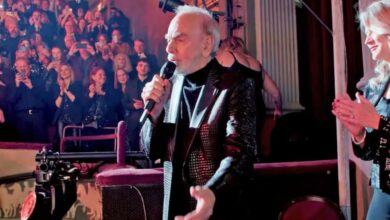Webb Pierce’s Unforgettable Performance of “There Stands the Glass”
“There Stands the Glass” is a poignant exploration of heartache and the human condition, weaving together the threads of sorrow, longing, and the complex allure of alcohol as a means of coping. The song, brought to life by Webb Pierce’s emotive vocal delivery, captures a universal struggle that resonates with many listeners. The raw emotion expressed through the lyrics tells a compelling story of a person grappling with the pain of lost love, finding temporary refuge in the comforting embrace of a drink. This narrative not only brings depth to the experience of heartbreak but also highlights the bittersweet nature of seeking solace in something that ultimately offers only fleeting relief.
With the collaboration of writers Russ Hull, Mary Jean Shurtz, and Audrey Grisham, the song embodies a profound sense of vulnerability. The opening notes evoke a deep yearning and quickly draw the listener into the narrator’s emotional turmoil. The act of reaching for a glass becomes a metaphor for both desperation and escape, mirroring the cycle many individuals face when confronted with despair. The imagery painted by the lyrics, combined with the melody, creates a space where listeners can reflect on their own experiences with heartache and the common human tendency to seek comfort in external substances.
Webb Pierce, known for his distinctive voice and passionate performances, played a pivotal role in the transformation of country music during the 1950s. His ability to infuse emotion into his music set him apart during a time when the genre was evolving rapidly. Pierce’s career flourished, delivering hit after hit that often encapsulated themes of love, loss, and heartache, which were relatable to his audience. His use of traditional instrumentation, particularly the steel guitar, added a unique sound to his music, contributing to a mood that was both reflective and haunting—essential elements found in “There Stands the Glass.”
The metaphor of green-hued liquor depicted in the song serves as a powerful symbol of the fleeting nature of comfort. Listeners can easily identify with the protagonist’s struggle; seeking solace in alcohol is a vividly relatable experience for many. However, the song acknowledges the temporality of such relief, prompting a deeper contemplation of the reasons behind such coping mechanisms. The clever interplay between music and lyrical content invites empathy, bridging the gap between artist and audience through shared experiences of sorrow and longing.
Upon its release in 1953, “There Stands the Glass” quickly rose to the top of the Billboard country charts, signifying its immediate resonance with a broad audience. Its popularity not only solidified Webb Pierce’s status as a country music mainstay but also marked the creation of a timeless classic that would influence future generations of musicians. The song has since been covered by various artists, each bringing their unique interpretations and contributing to the song’s rich legacy within the country music genre.
As the landscape of music continues to change, the emotional themes explored in “There Stands the Glass” remain ever relevant. The song’s ability to evoke deep emotions ensures its continued presence in the repertoires of contemporary musicians, and it frequently appears in live performances, radio playlists, and cultural references. This enduring appeal can be traced back to its fundamental exploration of lost love and the human propensity to seek comfort in the face of loneliness and despair.
Webb Pierce’s significant contributions to country music have left an indelible mark on the genre. Known for his major hits such as “In the Jailhouse Now,” “Love, Love, Love,” and “Wondering,” he established himself as a key figure in shaping the sound and storytelling aspects of classic country music. His impressive career, highlighted by numerous accolades and honors, including several Grand Ole Opry memberships, set a standard for future artists aiming to tap into the emotional core of their songs.
Pierce’s legacy extends beyond his own work; he serves as a wellspring of inspiration for aspiring musicians who recognize the power of storytelling in music. His ability to convey profound emotion through song has influenced a generation of country artists, establishing a benchmark for authenticity and heartfelt expression. “There Stands the Glass” exemplifies this narrative-driven approach, showcasing how personal stories can resonate with a collective audience.
The significance of “There Stands the Glass” is not only rooted in its lyrical content but also in the cultural impact it has had within the country music landscape. As an emblem of emotional authenticity, the song challenges listeners to engage with their own feelings of sorrow and longing, promoting an understanding of shared human experiences. Webb Pierce’s interpretation highlights the transformative power of music, turning individual heartache into a universal narrative that reflects the complexities of life.
In contemplating the enduring legacy of “There Stands the Glass,” one cannot overlook its role in establishing a deeper emotional connection between artist and audience. Webb Pierce’s emotive performance and the songwriters’ skillful crafting of the lyrics invite listeners into a space of reflection and empathy. As time goes on, this classic country song remains a testament to the struggles of the human heart, ensuring its place as a timeless staple within the annals of country music history.



